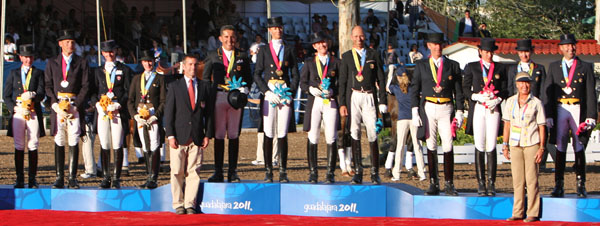New Pan American Games Test Event Format Approved by FEI Groups Representing Americas
11 years ago StraightArrow Comments Off on New Pan American Games Test Event Format Approved by FEI Groups Representing Americas

By KENNETH J. BRADDICK
A unique format of mixed big and small tour teams in a Florida test event as the most ambitious effort so far to raise Pan American Games dressage to Grand Prix level has been approved by the three International Equestrian Federation (FEI) groups that represent 30 nations throughout the Americas.
The Nations Cup event is considered key not only to elevating the Pan Ams to the same level as the European Championships but to provide support to efforts to increase the total number of dressage combinations at future Olympics. Dressage is a stepchild at the Oympics with an allocation of 50 starting combinations compared wth 75 each for eventing and jumping.
“Dressage,” one FEI official said, “really delivered the goods in London, way beyond the wildest expectations. Fabulous competition, sellout performances, everything one could dream of.”
The three Olympic disciplines of dressage, eventing and jumping are an essential and successful element of the Pan Ams, the world’s largest multi-sport event after the Olympics themselves. They are also an Olympic qualifier held once every four years in the year before the summer Games. The next Pan Ams are scheduled for Toronto in 2015.
There is some resistance within Latin America to raising the level to Grand Prix from Prix St. Georges/Intermediaire on the grounds that there are not enough big tour horses to make up more than a small handful of teams–Brazil, Canada and the United States the prime prospects with only one or two more nations given a chance.
Further, the 2011 Pan Ams at Guadalajara, Mexico, were the most successful ever with a record 12 nations fielding teams in an atmosphere that more than matched any equivalent championship. The U.S., that had qualified for the Olympics at the World Equestrian Games the year before, won gold while Canada took silver for one of the two berths reserved from the Pan Ams for London. Colombia won bronze that was historic for giving the nation a ticket to London with the proviso that three combinations to make up a team had to earn minimum qualifying scores. None did despite a concerted and expensive attempt, including leasing horses in Europe.
The result was that only a single combination from south of the United States border, Brazil’s Luíza Tavares de Almeida and Pastor competed in London. At the next Olympics in Rio de Janeiro in 2016, Brazil as the host nation, automatically receives a dressage team spot.
Although the FEI stated that only teams from the Americas will be able to compete in the Nations Cup, combinations from outside the Americas such as from Europe and Australia will be part of a blind draw to make up places on teams that do not have enough horses and riders.
And there are indications that if there are not enough places on teams for all non-Americans seeking to compete, additional teams may be added so no one is excluded.
The 2012 Nations Cup of six teams included squads from Europe and Australia.
The FEI hopes that federations and individuals will give the test event a chance before weighing in with opinions.
“Maybe it will turn out to be totally the wrong thing to do,” one official said. “Maybe it will be half right and half wrong. But we have to stop somewhere and say, ‘let’s give it a shot and see how it works’.
“During the event and after it we want everyone’s opinion–good, bad or indifferent.”
Spearheading development of the format and working on ways to implement it has come primarily from Maribel Alonso de Quinzaños of Mexico, a FEI 5* judge and active in governing the sport, and Thomas Baur of Germany, a member of the FEI Dressage Committee and organizer of several major European events.
The test event in Florida is being organized by Equestrian Sport Productions that created and manages the Global Dressage Festival, among the world’s richest dressage circuits, and the companion Winter Equestrian Festival that is the premier winter circuit for jumpers.
Millions of dollars were spent building the world class Global Dressage Festival grounds.
Well over another million dollars in legal fees have been spent by the organizers to fight efforts by the local government to close down or severely curtail dressage operations that include the dressage Nations Cup despite its importance to global equestrian sports.

